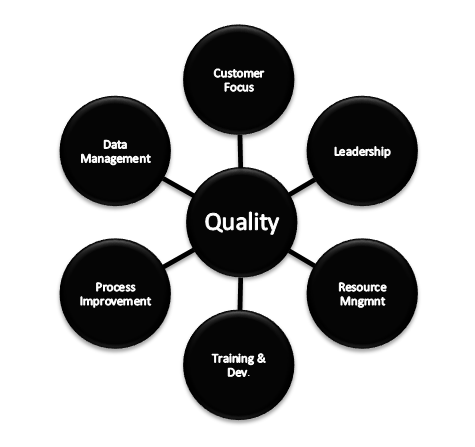Quality management is not a new concept to many industries. As far back as the 13th century, there were established models for managing and improving product quality. A discipline that started in manufacturing migrated to service industries such as hospitality, hotels, and healthcare.
As these industries embrace quality concepts, we as consumers develop higher expectations for positive, error-free service experiences. Whether it’s a product free from defects or services that are customer-friendly and offer ease of use, we’re constantly raising the bar.
6 Areas of Quality Your Church Should Focus On
Because of this phenomenon, there’s an increased pressure on nonprofit and church organizations to embrace quality concepts. The church has been slow to make these types of changes because of a resistance to corporate business practices spilling over into the church.
This quality movement is now a part of the service sectors, making it even more important for churches to incorporate quality concepts, methods, and processes into how they oversee church operations.
Church quality is about how you manage ministry resources, which are people, time, and money. To understand this better, you need to ask a few questions:
- Are you managing your people (employees and volunteers) with the best systems and processes available?
- Do you make sure you spend your time solely on those things that help further your mission?
- How do you manage the money God provides through someone’s donation? Are you deliberate with your spending or haphazard with your financial resources?
- Do you create an inviting environment through the maintenance and aesthetic look of your facilities?
- Do you communicate intentionally and with focus?
- Do your members, volunteers, and employees understand what you’re trying to accomplish? But more important, do they understand why you do what you do?
These are all things you should continuously think about.
Fire Prevention vs. Fire Fighting
Question: Is your organization better at putting fires out or better at fire prevention?
Good quality processes can prevent those recurring fires that we all have to deal with – sometimes on a daily basis. For example, if you get recurring complaints, take the opportunity to put a plan in place to eliminate the source of the complaint instead of getting really good at appeasing the complainers.
This is the difference between fire prevention and fighting fires. Fire prevention focuses on greatly reducing or eliminating the possibility of a fire starting!
For instance, the church welcomes everyone, but that doesn’t necessarily mean it should put a known predator in the children’s ministry. If the volunteer department diligently does background checks on all new volunteers, the information could make the organization aware of personal issues that could potentially affect a volunteer’s role and possibly safeguard members and children from a potential predator. Performing due diligence on the front end of the screening process can help to eliminate issues on the back end. That’s fire prevention!
Quality is woven into everything we do, and it really is the how we do things. It’s how we:
- Lead and develop people.
- Manage limited resources.
- Emphasize training employees and valuable volunteers.
- Systematically improve what we do by constantly looking at our systems and processes to ensure they’re as efficient and effective as possible.
- Identify and solve the problems we deal with every day.
- Know that we’re doing what we want to do and whether or not we’re successful at it
- Measure success.
Gather, study, and make decisions based on our data and asking ourselves, is every decision we make data driven? If not, we may be making some poor decisions.
Church quality is about how to manage church operations!
If you look at your organization from 50,000 feet, you can see how quality ties into to everything you do.

1. Customer Focus
Starting with the customers (those are the church’s members, volunteers, employees, and visitors), use quality tools to ensure you take care of all customer groups. You want to take care of the members because they fund the church, you want to take care of the volunteers because they’re the labor of the church, and you want to take care of the employees because they facilitate the process.
But most important, you want to create a friendly and welcoming experience for your visitors. If God sends visitors your way, you want to keep them.
Understanding these important customer groups, and developing strategies to meet the needs of each group, will not only help to strengthen the core but also grow the church.
Do you solicit feedback from your customers (members, volunteers, or employees) and ask questions that will help you better manage your operation?
2. Leadership
Quality takes into consideration your leadership model and how you identify and transfer leadership skills to others. You need to constantly look for ways to develop the next generation of leaders.
This means identifying what leadership abilities you want your leaders to display and creating a system to identify candidates and systematically train them to ensure new leaders are always in development. For instance, some organizations rotate volunteers out of leadership positions every couple of years in an effort to keep things fresh and to avoid volunteer burnout. Having a process to constantly identify and train leaders allows for smooth transitions.
3. Resource Management
Every organization has limited resources (people, time, and money), so it’s important to establish processes to prioritize the allocation of those resources.
For example, creating a church budget allows for intentional use of church financial resources. Or including an analysis of staffing levels (employee or volunteer) when planning a big event can help to ensure the event is manageable and there are enough hands to do the work.
4. Training and Development
Training and developing the core group of employees and volunteers is critical to ensuring desired behavior, and an understanding of job expectations. You should have structured training programs that include all core competencies as defined by the leadership. These competencies should include things like customer service skills, problem solving, conflict resolution, in addition to technical skills like computer literacy and organization-specific software programs.
Successful training programs require some funding but can have a significant impact on how the organization operates and meets the needs of all of its customer groups.
Process Improvement – It’s important to continuously look at internal processes and work to make sure they’re as efficient and effective as possible. Donald Berwick is a pediatrician who led the quality movement into the healthcare industry in the 1990s, and he said, “Every system is perfectly designed to achieve exactly the results it gets.”
What he meant was a bad system will produce bad results every time, and a good system will produce good results. A good employee put in a bad system will have bad results. However, the same employee put in a good system will have great results.
For example, if the process to drive onto and off your church campus is slow week after week, visitors and even members may get frustrated. And, unfortunately, sometimes they even vote with their feet. The worst part is it’s often the parking volunteers who have to deal with the bad process, which creates a negative experience for both those who use the process and those who manage it.
5. Data Management
Data provides us with information about how the organization operates. Gathering and using this data can help us make better-informed decisions.
I used to tell my employees, “If I don’t know it’s broke, I can’t fix it.” What I meant by this was unless I’m (you’re) aware of the issues, we can’t find a solution. Whether the issue is a lack of resources to pull off a big event or declining weekly attendance, you need to put a plan in place to address these problems.
Computer systems make accessing church data pretty easy. However, there are times when you need to collect data manually. For example, if the children’s ministry has a minimum worker to child ratio, and the children’s church has to turn away kids because there aren’t enough volunteers to staff it, you need some sort of tracking mechanism to collect this data. Once you collect the data, it gives the children’s ministry coordinator the information needed to solicit help and support from church leadership.
6. Organizational Assessment
Once you decide to develop a quality management program, the first step is to do an organizational assessment. You can do this in-house or by using an objective third party consultant. The goal of the assessment is to provide information about the organization and to identify areas that need focused planning and attention.
When doing an assessment, some things you should discuss are finances, resource allocation, leadership, customer experience, internal processes, training and development, and data management.
The quality movement is now a part of the service sectors, making it even more important for churches to incorporate quality concepts, methods, and processes into how they oversee church operations.
Paying attention to the little things can have a major impact on the perception of the church. And paying attention to the small details takes hard work, focus, and a commitment to excellence! And, who more than the church should do things with excellence!
Question: How can the church expect the world to take us seriously unless we represent the Father with the excellence that He deserves in everything we do?

